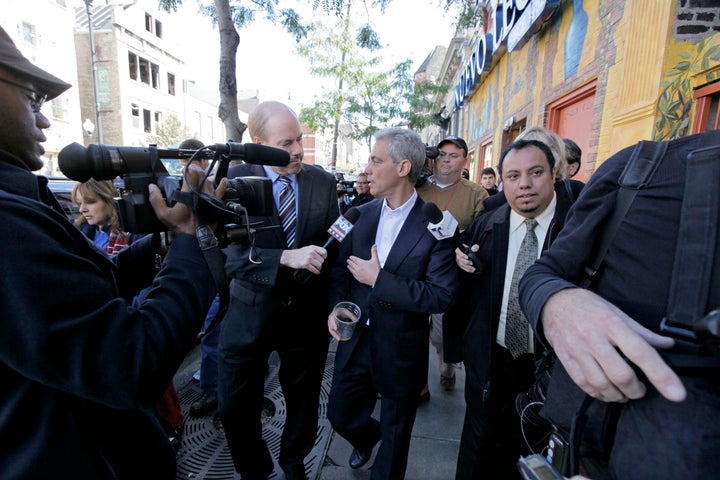
CHICAGO -- The City of Chicago has more Mexicans than Veracruz and more Puerto Ricans than Arecibo. But despite these huge urban numbers, Latinos in the region are now more likely to live in a suburb than in one of Chicago's 50 wards. And as Latinos search for broader lawns and better schools, their shifting demographics mean Chicago and the region as a whole will face a changing political and social landscape.
In 1990 Chicagoland's Latino population center stood inside city limits. By 2000 it had crept out into suburban Cook County. The latest census results, released this year, show the center of Latino gravity continuing its westward march almost into DuPage, the next county over.
In the ongoing remap of Chicago's ward boundaries, the city's Latinos, the majority of whom are of Mexican descent, seem poised to gain several seats on the City Council. It seems likely that very soon, some Chicagoland suburbs could follow suit in terms of greater Latino representation.
But the dispersion of Latinos across the region could also prove problematic for redistricters looking to create majority-minority districts.
During state-level redistricting, Juan Rangel, CEO of the influential United Neighborhood Organization and a key Latino backer of Rahm Emanuel during the former Obama adviser's mayoral campaign, supported a plan others had criticized for creating too few Latino-dominated seats.
Rangel says he isn't worried about the increasing diffusion of the Chicago region's Latinos.
"I think the dispersed community is the reflection of a successful community as people move up and out," he told HuffPost. "That's a natural phenomenon and there's nothing wrong with that."
He declined to say Chicago needed more Latino alderman, arguing instead that the city needed more alderman who represented Latino interests. "It's always up to those communities to elect the people they choose to elect, whether they are Hispanic or not," Rangel said.
Navigating the treacherous ethnic and racial currents of this process will present a major challenge for Rahm Emanuel -- who defeated two Latino candidates on his way to becoming mayor -- during his first year in office.
NEW MAPS
Other community leaders disagree with Rangel's take on the best way to integrate Latinos into the region, and to ensure they receive sufficient political representation.
As the Chicago Tribune noted last month, if the City Council were representative of the city's demographics, it would have 15 Latinos -- but instead it only has eight.
But that could change this year, as Latinos organize to get their share of representation within the city during the remapping of the city's ward boundaries triggered by the census numbers.
Alderman Danny Solis is leading the effort by the City Council's Hispanic Caucus during the remap. So far he has been tight-lipped about what his aims are, but another alderman, Ricardo Muñoz, has said he hopes Latinos can wrest between four and six seats out of the redistricting process.
In part, the growing number of Latinos in the city is simply becoming too large to ignore. The city's Latino population grew by 25,000 in the past decade -- a number that stands out even more when considering the city as a whole lost 200,000 people.
Rob Paral, an analyst and consultant who studies Latino demographics, noted that one significant under-reported element of that growth is that Latino Chicagoans are increasingly American citizens. In 2000 the naturalization rate among immigrants was 39 percent; by 2009 that number had jumped to 45 percent by Paral's estimate. If immigration continues the slowdown seen over the past decade, Paral believes the city's Latino residents will increasingly be eligible to vote -- and increasingly sought after by politicians.
The census data also show middle-class Mexican-Americans are leaving the city for the suburbs. In some cases, they are being joined by a population of new immigrants, who are increasingly skipping the city and its traditional port-of-entry neighborhoods like Pilsen for places where they are more likely to find jobs and other opportunities.
While Latino population grew by 3.3 percent within the city, in suburban Cook County, it grew by 46.5 percent. In Kendall County, a full 40 miles southwest of Chicago Latinos' numbers increased by an astonishing 338 percent, adding some 50,000 people in just 10 years.
"A large number of Latinos have predominantly chosen smaller communities where they have more affordable housing," said Rosa Ortiz, a senior planner at the Chicago Metropolitan Agency for Planning (CMAP).
SUBURBAN CHALLENGES
Now, bedroom communities and suburban towns are grappling with problems they may have never seen before, like creating affordable housing and providing education for English language learners. CMAP has also identified access to transit as a major concern for Chicago's suburbs, which rely on scattered bus lines to get lower income earners to work.
The Interfaith Housing Center of the Northern Suburbs, based in Winnetka, Ill., released a report earlier this year detailing the problems that have sprung up in the wake of this demographic shift.
Using volunteer testers in a sort of secret-shopper approach to the region's housing market, Interfaith conducted an audit of 18 rental units "to uncover differential treatment based on national origin (Latino and Asian)." The group found, "the non-Anglo testers were not treated as well in 4 audits (22 percent)." Testers in the study encountered requests for higher security deposits, bigger fees and general caginess by rental agents.
Interfaith's Immigrant Integration Initiative Project Director Alicia De La Cruz, said she had experienced the sting of discrimination herself when she took her daughter to school in Highland Park, a Chicago suburb. Her reception when she arrived, she says: Other parents assumed she was the nanny.
"I never felt that they didn't like us, until I had my daughter," De La Cruz said. Still, she's active in school organizations and said she doesn't plan on going anywhere.
"I don't want to leave Highland [Park] because I came here directly from Mexico," De La Cruz said, "and this is my second home."
Aside from problems with housing and discrimination, Interfaith's report also highlighted another issue for suburban communities: "Relatively few immigrants are actively involved in local government," it asserted.
"Despite a growing presence and significant economic contribution of immigrants to these communities, they are invisible when it comes to political muscle," the report concluded.
"I think the people in the suburbs have to agitate for the services that they need, and that's a big challenge," said Father Chuck Dahm, of the St. Pius V Parish in Chicago's Pilsen neighborhood. "They don't have the political clout they need because the old guard keeps control of the power."
A CHANGED NEIGHBORHOOD
Pilsen is still dotted by Mexican groceries, but over the last decade it has lost almost a fifth of its Latino population. Dahm has ministered to a predominantly Mexican-American population there for 45 years. These days, he said, "at least half of our members from our parish come [to worship] from outside of our zip code."
Many Latinos are now traveling to Dahm's church because they've moved out of Pilsen due to changes in the neighborhood's own demographics.
The University of Illinois at Chicago created a major housing development at the edge of the neighborhood at the turn of millennium. That development drew wealthier gentrifiers -- many of them white, some of them Mexican-American -- who have raised rents for everyone. While Dahm's parish has sought to both welcome the newcomers and create more affordable housing units for other neighborhood residents, he notes Pilsen's Latino population is shrinking.
When people come to church from outside the area or the city, Dahm said, "it lessens their commitment to work in the neighborhood."
Another challenge for the neighborhood, and the city, is an aging Latino population. Regionally, the Latino population's 65-and-older segment grew an astounding 69 percent between 2000 and 2010, according to an analysis by the Chicago Metropolitan Agency for Planning.
Dahm said he saw the trend reflected in the reception a new senior housing development built under the auspices of The Resurrection Project, an non-profit in Pilsen. He had been worried that Mexican-Americans' strong intergenerational ties would make them reluctant to put their parents into senior housing.
"I questioned whether or not we would find enough people who wanted to go," Dahm said. But he was surprised when "we filled this 72-unit building in a manner of five or sixth months."
As some Latinos head for the suburbs and others age, some might worry that Pilsen will stop serving its traditional role as a center of the region's Mexican-American community.
Not necessarily, said Carlos Tortolero, who heads the National Museum of Mexican Art in Pilsen.
Tortolero's own journey is indicative of the course Mexican-Americans in the city are increasingly taking. He was born in Mexico and moved to the United States at age three, growing up in Chicago. When it came time to raise his own children, however, he moved to the suburb of Berwyn. What he was searching for was no different than what many other people seek when they leave cities: a bigger house and better schools.
Tortolero acknowledged it might be bad for his museum's business if Latinos move out of Pilsen. But while he said the neighborhood is "going to be gentrified, that's for sure," he said he isn't worried that it will cease to be the beating center of the region's Mexican-American community.
"Pilsen's holy ground for our community," Tortolero said. Declining Latino population or not, he believes it will stay that way.
As for the rest of the region, Tortolero believes more Latinos in the suburbs mark a healthy demographic shift: "We're everywhere, for God's sake."
